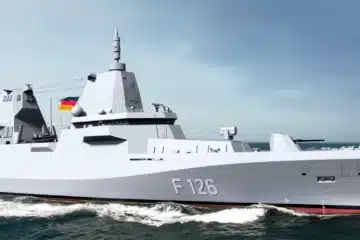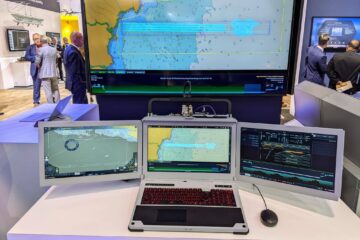The North Sea is in a state of high alert, much like most of the High North. The range, speed, power and variety of threats, such as ballistic missiles, has significantly grown over the past decades, making it increasingly difficult to ensure constant protection of surface and sub-surface critical infrastructure. “It is not only a matter of capabilities and systems,” Geert van Der Molten, Vice President of Sales of Thales NL, told the media, “it is also about shortages of components, inflation and shortage of human resources adding to those threats.” As a result, it is difficult to envisage one nation alone being capable of tackling such wide variety of threats.
In such context, Collaborative Engagement Capabilities (CEC) has become a critical capability over the past few years. Central to CEC is the notion of networking different sensors and systems in order to increase situational awareness and, where necessary, extend the fire control loop to more than one unit. The crucial importance of this sensor netting was evident throughout the press trip last week, and a couple of examples demonstrated Thales’ and, more broadly, navies’ growing focus on such area.
Launch on remote
Rogier Noorland, Product Manager Integrated Air Missile Defence (IAMD), explained how the Royal Netherlands Navy (RNLN) and the US Navy (USN) used the Formidable Shield 2021 exercise to test ‘launch on remote’ capabilities. During an exercise, HNLMS De Zeven Provinciën’s new SMART-L MM (multimission) radar – which replaced the legacy SMART-L – detected a simulated ballistic missile launch. Two courses of action were possible:
- Triggering the early warning capability, “which can result in either passive air defence – and alerts civil authorities of the danger – or active air defence means;”
- Switching to engagement support mode with another platform. In this case, HNLMS De Zeven Provinciën data was used to launch an SM-3 (an exoatmospheric interceptor) from nearby USS Paul Ignatius, successfully destroying the ballistic missile flying 14,000km per hour through space.
“The exercise demonstrated launch on remote capabilities, that is, the Dutch frigate becomes part of the US destroyer’s fire control loop,”
Rogier Noorland, Product Manager Integrated Air Missile Defence (IAMD) at Thales

Plot Level Data Exchange and Fusion (PLDEF)
The next step for Thales, Noorland also told reporters, will be facilitating the exchange and integration of radar data. This new capability, called Plot Level Data Exchange and Fusion (PLDEF), aims to provide a more precise, near real time, continuous picture for radar operators on each ship involved in the network: if all connected radar receive the same information, there are no track drops across the force. Finally, the PLDEF could also significantly contribute to Electronic Warfare (EW) resilience. “While jamming one or two radars in a task force is standard, jamming all radar on all bands would be far more complicated”, Noorland pointed out.
While the Thales teams could not comment on the PLDEF’s technology readiness level (TRL), they did mention two key milestones:
First, initial tests have been carried out between a Dutch and a French frigates. In this instance, the two ships exchanged radar measurements through each navy’s respective battlespace labs, thus facilitating accreditation for the exchange of highly confidential data.
Second, Thales has submitted a bid for the 2021 call of the European Defence Fund (EDF) on “Naval collaborative surveillance” to support work on this new CEC capability. Bid winners should be announced mid-2023. A large share of the work that remains to be done on the PLDEF lies in the ability to exchange high volumes of data between two countries. “Effectively we are aiming to create a new exchange standard,” Noorland told Naval News.

CEC: The future of naval warfare
CEC is, undoubtedly, the future of naval warfare. By facilitating collaborative early warning and engagement across different units, it offers navies the ability to tackle increasing resource issues – human, components and funding. The four De Zeven Provinciën-class frigates are an excellent example of this trend. All four ships will be fitted with the new SMART-L MM, allowing them to perform tasks and collaborative engagement like HNLMS De Zeven Provinciën did during the Formidable Shield 2021 exercise. Not all four frigates, however, will receive the new APAR (Block II) and the new Sabre Electronic Counter Measure (ECM) due to cost concerns, as announced by an RNLN press release published in May 2022.
Two of the four frigates are now back to being operational – HNLMS De Zeven Provinciën, which participated in Formidable Shield 2021 and HNLMS Tromp, which will participate in Formidable Shield 2024. HNLMS De Ruyter, which the media visited last week, will see her maintenance period end in March 2023, marking a longer refit period than usual due to the many upgrades the ship received. The work-up will start soon after, but it will be interrupted midway to allow for crew training and will resume only in the spring of 2024 in time for meeting the scheduled return to operations in the summer of 2024.
HNLMS Evertsen is still undergoing maintenance and will be the first of the four frigates to receive the new 127mm Leonardo naval gun system – which will significantly alter the forward part of the ship, beyond the VLS.
Welmer Veenstra, De Ruyter’s Commanding Officer, told the media that the frigates would continue receiving upgrades until the new Anti-Submarine Warfare Frigates (ASWF) are operational. According to Marco Strijker, Marketing Manager at Thales Netherlands, the contract should be awarded this year, for a first ship to be operational by 2028.






